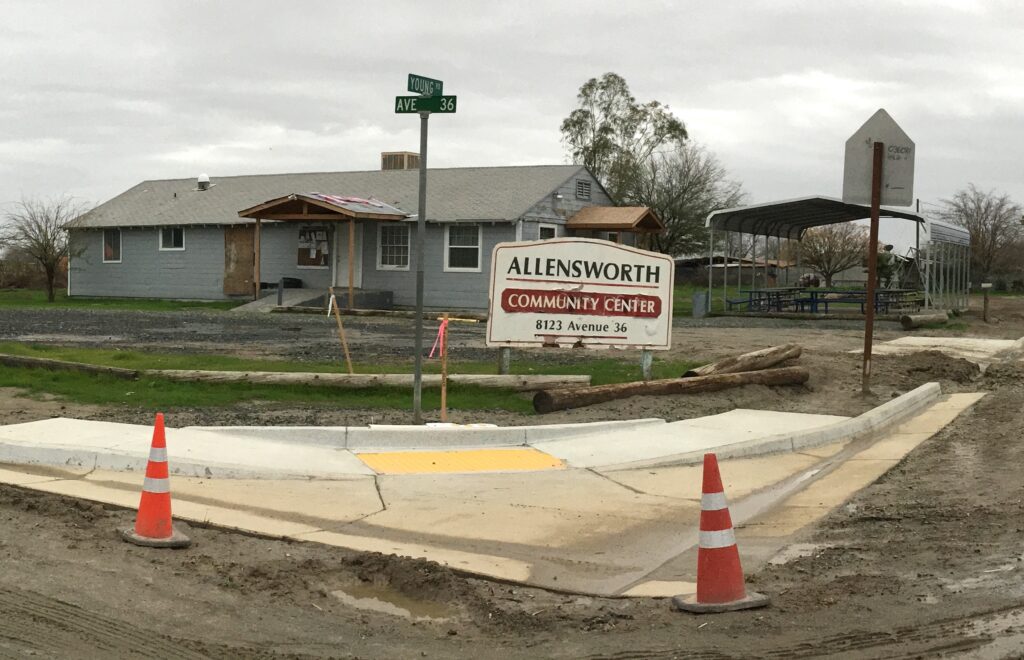When it comes to finding innovative solutions to drinking water problems, the tiny community of Allensworth in Tulare county has long been on the front lines.
This spring, the community began testing a new technology that would “jolt” arsenic out of its groundwater. And since 2021, Allensworth has also been home to another new technology that “makes” water out of thin air.
Both technologies are currently being field-tested in Allensworth. If successful, they could become viable paths to clean water for residents of Allensworth and other small, rural San Joaquin Valley communities that are plagued with contaminated water or unreliable supplies – especially during California’s prolonged droughts.
Even if both technologies on trial in Allensworth are wildly successful, however, the state Division of Drinking Water will require a great deal of convincing before approving either, or both, as an acceptable alternative to other, less “sexy” solutions, such as drilling new wells or hooking up to a larger system, etc.
That potential speed bump hasn’t deterred Allensworth leaders from seeking any feasible way to get residents a permanent supply of clean water so they can kick the unsustainable bottled water fix many of them live with now.
“There’s no reason we should continue to have these pitfalls and problems that happen with no solution in sight,” said Denise Kadara, vice-chair of the state Central Valley Regional Water Quality Control Board and resident of Allensworth. “Those interim solutions are not the best fix because they continue to create more environmental problems.”
Experimenters
The town has partnered with a hydropanel company to make water from ambient air using solar energy and condensation. Hydropanel company Source Global installed two panels in Allensworth in March of 2021.
The town is also the beta site for a UC Berkeley technology which is able to remove nearly all traces of arsenic from water using electricity and rust. A test run of the technology was set up on May 10 and will run for four months.
Experimentation is nothing new in Allensworth, which was established in 1908 by Colonel Allen Allensworth, a former slave, as a community governed by and for Black Americans. The town flourished for years, but eventually people started moving away and growth declined. It’s now home to about 500-600 residents and is the site of a historic park and monument.
The founder and early residents of Allensworth didn’t know about the dangerous naturally occurring arsenic in the groundwater supply which can cause cancer.
Allensworth is not alone.
In April, the state Water Resources Control Board released its annual drinking water needs assessment. It analyzed more than 3,000 water systems in the state and found 346 are failing to provide safe drinking water. Another 508 are at risk of failing. That means the groundwater for those systems is at high risk of drought impacts or contamination by chemicals such as arsenic, nitrate, 1, 2, 3-trichloropropane, gross alpha, uranium and hexavalent chromium.
Inadequate solutions
The state often provides bottled water to communities that have unsafe drinking water. In some towns, local agencies have set up drinking water kiosks, where people can fill up water jugs for free.
But both options are inadequate, said Kadara. Plastic water bottles are a detriment to the environment. And water kiosks are a burden on people, she added.
Many people in rural communities don’t have consistent transportation, let alone a way to transport water from a kiosk back home, said Kayode Kadara, community advocate in Allensworth and Denise Kadara’s husband. And it’s often underserved, disadvantaged communities that suffer from drinking water issues, he said.
“Some of them will have to ride their bicycles. How are you going to get your water home on a bicycle?” said Kayode. “What’s the long term solution?”
With no solutions in sight, Denise and Kayode sought out partnerships with those who had ideas for potential answers.
Water from air
In early 2021, Kayode met with staff from Source Global, a company that makes hydropanels, a type of solar panel that generates water out of ambient air. Kayode was skeptical. Allensworth is arid and the temperature often reaches upwards of 100 degrees.
Kayode asked the company to install two panels on the Allensworth community center in March 2021 so the town could learn more.
The panels stopped working early on and Kayode’s skepticism grew. After a couple months, the company fixed the panels. The malfunction was caused by a broken gear and was apparently an isolated incident.
Since then, the panels have worked and Kayode and Denise now have more confidence in the technology. Each panel generates about one gallon of drinking water per day, as long as there is sunlight to power the panels.
“We have the expertise, we have some technically minded folks in the community, we have folks that look to make sure that those things that could be a benefit to the region and the United States as a whole are looked at closely,” said Kayode. “Anything that we hear about that we feel makes sense, we pursue it and ask questions.”
The hydropanels work by condensing water vapor in the air into liquid form, said Tom Borns, U.S. direct sales manager for Source Global. The panel takes in as much thermal energy as possible. The machine in the panel gets hotter than the surrounding air which is pulled in with a fan and liquifies. Then the water is mineralized and ready to drink.
The technology is expensive, admitted Borns. Each panel costs about $2,000. A single household needs 2-4 panels.
Source Global has panels all over the world, said Borns. But the company has an interest in the San Joaquin Valley in particular because of the widespread groundwater contamination. In 2021, nonprofit one2one USA Foundation committed $7 million to install panels on 1,000 homes throughout Fresno, Monterey, Kern and Tulare counties.
The panels in Allensworth have garnered attention. State senator Melissa Hurtado (D-Sanger) came to Allensworth to see the panels on March 29. According to a spokesperson, Hurtado thinks the hydropanels are an interesting idea but that more information is needed about the technology.
“People are not aware of how dire the situation is,” said Borns.
Give it a little a jolt
Allensworth is the site of another technology that, instead of generating new water, aims to clean up existing groundwater.
A team at UC Berkeley has developed technology that removes almost all arsenic from water. The researchers do this by submerging plates of steel into the water and running a small amount of voltage through them. The steel plates slowly dissolve in the form of rust which binds to arsenic allowing the arsenic to be filtered out of the water.
The technology has been running successfully for five years in India, said Ashok Gadgil, distinguished professor of civil and environmental engineering at UC Berkeley and faculty senior scientist at Lawrence Berkeley National Lab. Gadgil is leading the arsenic removal research project.
The team is turning its attention to the U.S., more specifically the San Joaquin Valley. A colleague who knew about Allensworth’s arsenic problems put community members in touch with Gadgil in 2017.
In 2018 Gadgil and his researchers tested the water directly beneath Allensworth and found arsenic at levels of 120-150 parts per billion (ppb). The state maximum contaminant level is 10 ppb. In an effort to find clean water, Allensworth had drilled wells several miles away that have lower arsenic levels of between 7 ppb and 14 ppb.
“Even 10 ppb is poison,” said Gadgil.
In 2019, Gadgil tested the technology in Allensworth for a week to show it was possible. But now comes the true field test.
On May 10, the technology was set up in Allensworth for a four month trial run to prove the method can work. In India, the technology took water with arsenic levels even higher than those in Allensworth and got them down to 3 ppb.
“I personally am confident that we will overcome any technical surprises that come up. I don’t think there are many left,” said Gadgil.
Gadgil’s research was paid for by a $1 million grant in 2017 from the state cigarette tax funds. And on April 11, the U.S. Environmental Protection Agency awarded Gadgil’s team $100,000.
After the four month trial in Allensworth, Gadgil doesn’t know exactly what will come next. The state has tough regulations on new arsenic technology, Gadgil said. Typically, new technology will need to operate in the field for years to prove credible to the state, he added. That type of extended operation and business modeling is not what the university is designed for, said Gadgil.
“Boring” but reliable
Meanwhile, the state still relies on other, more standard, options for valley communities with bad water.
“There are approaches out there but it involves largely working together and exploring boring technologies rather than hoping for Silicon Valley to solve it,” said Darrin Polhemus, deputy director of the state Water Resources Control Board’s Division of Drinking Water, on drinking water solutions.
The Water Board doesn’t provide funding for research on drinking water solutions. But it does provide a regulatory and permitting perspective, said Polhemus.
It’s also focused on solutions that are less “sexy” than new technologies, said Eugene Leung, drinking water treatment technical specialist for the division.
There is no standardized process for new drinking water solutions. The process varies on a case by case basis. But the options state staff typically look for are drilling new wells where possible and hooking communities up to larger, public water systems when feasible.
As for the technologies in Allensworth, the hydropanels only function when there’s sunlight so residents would still need bottled water as backup, said Leung. And, as Gadgil mentioned, the UC Berkeley tech will need to prove its reliability and consistency, Leung said.
Another “non-sexy” potential solution is replumbing communities’ water systems to separate out drinking water from all other domestic uses. That way, only the drinking water portion needs to be treated which means treatment methods can deal with far less water, said Polhemus.
In California, more than half of domestic water goes to outdoor uses, he said. If community water systems are restructured, there would be much less need for large, expensive treatment facilities since all domestic water doesn’t need to be treated, he added.
But replumbing entire communities is expensive and complicated.
Telling residents they’re going to be charged to pay for replumbing of their system is, “a bit scary,” said Polhemus. “There’s ways of financing it and ways of setting it up that I think can help people deal with that. But it does face a barrier.”
Regardless of the challenges and complications, Denise and Kayode feel optimistic about the future in Allensworth and for drinking water elsewhere.
“From my standpoint when I look at the possibilities going forward I feel very good that we are looking at potential long term solutions for some of the problems that we face here in the region especially in those areas impacted by the contaminants and in most cases disadvantaged communities,” said Kayode. “You can’t place any dollar figure to the value of life when you look at it in that context.”
Share this:
- Click to share on Facebook (Opens in new window)
- Click to share on Twitter (Opens in new window)
- Click to share on LinkedIn (Opens in new window)
- Click to share on Reddit (Opens in new window)
- Click to share on Tumblr (Opens in new window)
- Click to share on Pinterest (Opens in new window)
- Click to share on Pocket (Opens in new window)
- Click to share on Telegram (Opens in new window)
- Click to share on WhatsApp (Opens in new window)
- Click to print (Opens in new window)








